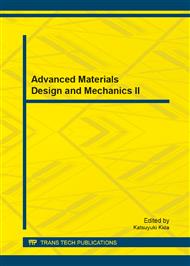[1]
M. Shafahi, V. Bianco, K. Vafai, and O. Manca, An investigation of the thermal performance of cylindrical heat pipes using nanofluids, Int. J. Heat Mass Transfer 53 (2010) 376-383.
DOI: 10.1016/j.ijheatmasstransfer.2009.09.019
Google Scholar
[2]
S. J. Palm, G. Roy, and C. T. Nguyen, Heat transfer enhancement with the use of nanofluids in radial flow cooling systems considering temperature-dependent properties, Appl. Therm. Eng. 26 (2006) 2209-2218.
DOI: 10.1016/j.applthermaleng.2006.03.014
Google Scholar
[3]
S. U. Ilyas, N. Marneni, A. Shuib, and R. Pendyala, Viscous and thermal transport properties of fluids with nanoparticles: A review, in The 2nd International Conference on Process Engineering and Advanced Materials (ICPEAM 2012), AMD-107-1569577413.
DOI: 10.4028/www.scientific.net/amr.917.18
Google Scholar
[4]
E. Iritani, T. Hashimoto, and N. Katagiri, Gravity consolidation–sedimentation behaviors of concentrated TiO2 suspension, Chem. Eng. Sci. 64 (2009) 4414-4423.
DOI: 10.1016/j.ces.2009.07.013
Google Scholar
[5]
W. Yu and H. Xie, A Review on Nanofluids: Preparation, Stability Mechanisms, and Applications, J. Nanomater. (2012).
Google Scholar
[6]
S. M. S. Murshed, K. C. Leong, and C. Yang, Enhanced thermal conductivity of TiO2-water based nanofluids, Int. J. Therm. Sci. 44 (2005) 367-373.
DOI: 10.1016/j.ijthermalsci.2004.12.005
Google Scholar
[7]
C. H. Lo, T. T. Tsung, L. C. Chen, C. H. Su, and H. M. Lin, Fabrication of copper oxide nanofluid using submerged arc nanoparticle synthesis system (SANSS), J. Nanopart. Res. 7 (2005) 313-320.
DOI: 10.1007/s11051-004-7770-x
Google Scholar
[8]
C. -H. Lo, T. -T. Tsung, and L. -C. Chen, Shape-controlled synthesis of Cu-based nanofluid using submerged arc nanoparticle synthesis system (SANSS), J. Cryst. Growth 277 (2005) 636-642.
DOI: 10.1016/j.jcrysgro.2005.01.067
Google Scholar
[9]
C. Z. Jia, Y. Q. Fan, H. Qi, and N. P. Xu, Study on the dispersion of nano-ZrO2 in water, Chem. Eng. 33 (2005) 47-49.
Google Scholar
[10]
F. M. Tiller and Z. Khatib, The theory of sediment volumes of compressible, particulate structures, J. Colloid Interface Sci. 100 (1984) 55-67.
DOI: 10.1016/0021-9797(84)90411-9
Google Scholar
[11]
Y. Li, J. e. Zhou, S. Tung, E. Schneider, and S. Xi, A review on development of nanofluid preparation and characterization, Powder Technol. 196 (2009) 89-101.
DOI: 10.1016/j.powtec.2009.07.025
Google Scholar
[12]
X. Li, D. Zhu, and X. Wang, Evaluation on dispersion behavior of the aqueous copper nano-suspensions, J. Colloid Interface Sci. 310 (2007) 456-463.
DOI: 10.1016/j.jcis.2007.02.067
Google Scholar
[13]
I. Palabiyik, Z. Musina, S. Witharana, and Y. Ding, Dispersion stability and thermal conductivity of propylene glycol-based nanofluids, J. Nanopart. Res. 13 (2011) 5049-5055.
DOI: 10.1007/s11051-011-0485-x
Google Scholar
[14]
M. Shirato, H. Kato, K. Kobayashi, and H. Sakazaki, Analysis of settling of thick slurries due to consolidation, J. Chem. Eng. Jap. 3 (1970) 98-104.
DOI: 10.1252/jcej.3.98
Google Scholar
[15]
X. Wei and L. Wang, Synthesis and thermal conductivity of microfluidic copper nanofluids, Particuology 8 (2010) 262-271.
DOI: 10.1016/j.partic.2010.03.001
Google Scholar


